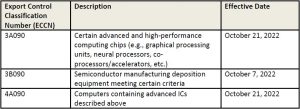Pillsbury Law Group Analysis of Recent U.S. Commerce China-Related Export Controls
U.S. Commerce Department Imposes Sweeping China-Related Export Controls on Advanced Computing and Semiconductor Manufacturing Items
SOURCE: Pillsbury Trade Sanctions Blog
On October 7, 2022, the U.S. Department of Commerce’s Bureau of Industry and Security (BIS) issued an interim final rule (the “Rule”) imposing sweeping new export controls targeting certain advanced computing integrated circuits (ICs), computer commodities that contain such ICs, and certain semiconductor manufacturing items intended for the People’s Republic of China (PRC).
The changes in the Rule have varying effective dates; some were effective immediately on October 7, 2022, others became effective on October 12, 2022, and the rest will go into effect on October 21, 2022. The pending changes include the new foreign direct product rules and controls on certain high-performance chips and computers.
New Categories of Export Controls
BIS added a new Regional Security (RS) control, which imposes a license requirement for exports, reexports and transfers (in-country) of newly controlled items to or within the PRC. The new RS license requirements do not apply to deemed exports or reexports.
Key new Export Control Classification Numbers (ECCNs) are summarized below (click to enlarge):
BIS is issuing a Temporary General License (TGL) effective October 21, 2022 through April 7, 2023 in order to avoid supply chain disruption for items that may be produced in the PRC but are ultimately destined for customers outside of the PRC. The TGL permits exports to the PRC and transfers within the PRC of 3A090 and 4A090 items, along with associated software and technology, to engage in various production activities. The export or transfer must be to a company not headquartered in Country Groups D:1, D:5 or E. The TGL does not authorize exports or transfers to “end-users” or “ultimate consignees” in the PRC, but it enables companies to engage in testing and assembly of covered items in the PRC.
New Semiconductor and Supercomputer Manufacturing End-Use Rule
The Rule creates a new section 744.23 of the EAR with additional end-use controls for items subject to the EAR intended for use in either semiconductor fabrication facilities or supercomputers in the PRC.
First, the aspect of the rule addressing semiconductor manufacturing end use creates license requirements for items subject to the EAR intended for certain semiconductor fabrication facilities in the PRC. A public briefing by BIS suggests the focus of the restrictions are on facilities responsible for achieving the identified technology parameters in the rule.
Second, license requirements are expanded for facilities in the PRC that produce either: (a) certain Logic ICs produced at 16 nm or 14 nm technology nodes or less; (b) certain NAND memory ICs; or (c) certain DRAM ICs.
Finally, licenses will be required for many ICs (not just advanced ICs) when you know the item would be used in a supercomputer located in or destined to the PRC.
Three New Foreign Direct Product Rules
The foreign direct product (FDP) rules treat non-U.S.-made items as being subject to the EAR if they are a “direct product” of certain U.S. software or technology. The Rule creates three new FDP rules, which are effective October 21, 2022.
The first FDP rule applies to 28 entities on the Entity List that are now designated with a Footnote 4 notation. The Footnote 4 FDP Rule is similar to Footnote 1, which currently applies to Huawei and its designated affiliates, though this rule has potentially broader application to cover an even wider range of foreign-made items as it includes ECCNs 5D002 and 5E002.
The other two FDP rules apply to advanced ICs and supercomputers. Accordingly, the new rules expand U.S. jurisdiction over certain non-U.S.-made ICs and non-U.S.-made items intended for incorporation into supercomputers.
New Restrictions on U.S. Person Activities
The Rule restricts the ability of U.S. persons to engage in business related to semiconductor development or production within the PRC. The rule imposes a license requirement, effective October 12, 2022, on U.S. persons that “support” the “development or production” of certain ICs at certain China-located semiconductor fabrication facilities, similar to the new supercomputer end use rule at §744.23. Covered support activities include the shipping, transmitting, or transferring (in country) of certain items, and facilitating the same, when being sent to certain PRC-located semiconductor fabrication facilities. The Rule applies to U.S. citizens wherever located.
Unverified List & Potential Entity List Designations
In a separate rulemaking, BIS added 31 parties to its Unverified List (UVL). Parties on the UVL are ineligible to receive items subject to the EAR by means of a license exception. In addition, exporters must obtain a statement from such parties prior to exporting any item subject to the EAR which is not subject to a license requirement.
Importantly, the BIS Office of Export Enforcement also issued a policy memorandum in conjunction with the latest designation. This policy calls for adding parties to the UVL 60 days after checks are requested but host government inaction prevents their completion, and an additional 60-day process for adding UVL parties to the Entity List when there is a sustained lack of cooperation by a host government to facilitate completion of the checks. Accordingly, it is possible that the recently designated parties on the UVL will be added to the Entity List if BIS is unable to complete an end use check within 60 days of the October 7 designation date. This would significantly expand restrictions and likely impose license requirements for all items subject to the EAR. On the other hand, companies that provide information and cooperate with BIS officials can be removed from the UVL.











